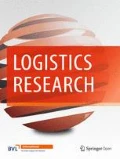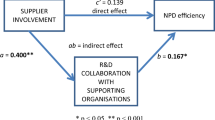Abstract
“Global Sourcing” has received a great deal of attention recently, as companies strive for new sources of competitive advantage in the face of increasing global competition. Alongside the undisputed role that supplier management plays in assuring sourcing success, organisational aspects can also be shown to play an important part in the field of global sourcing. This paper is a first systematic attempt to identify the factors that can successfully promote the execution of sourcing projects in “emerging markets”. The success factors are derived from the literature of related areas of research. The analysis adopts an internal perspective, although external factors residing in the relationship with the supplier and the external environment are indirectly taken into account by incorporating research on project and innovation management—both very flexible approaches for highly uncertain environments. The findings allow the identification of clearly relevant success factors in sourcing from emerging markets and are integrated in a model designed to explain the impact of organisational support in this venture. The partial least squares method (PLS) is used to test the model on a set of 96 cases. The data originates from a survey of sourcing managers from Europe, mainly in the manufacturing and automotive industries.










Similar content being viewed by others
References
Straube F et al (2007) International procurement in emerging markets: discovering the drivers of sourcing success. Deutscher Verkehrsverlag, Bremen
Moller MM, Johansen J, Boer H (2003) Managing buyer–supplier relationships and inter-organisational competence development. Integr Manuf Syst 14(4):369–379
Lay G, Eggers (2004) Ausblick: transnationale Netzwerke bewerten und controllen-die zukünftige Herausforderung. In: Erfolgsfaktor Standortplanung : in-und ausländische Standorte richtig bewerten; mit 40 Tabellen. Springer, Berlin [u.a.]
Arnold U (1997) Beschaffungsmanagement. 2., überarb. und erw. Aufl ed. Sammlung Poeschel; 139. Stuttgart: Schäffer-Poeschel. XV, 290 S
Bagchi PK, Skjoett-Larsen T (2005) Supply chain integration: a European survey. Int J Logist Manage 16(2):275
Fischer M (1993) Marketing und neuere ökonomische Theorie: Ansätze zu einer Systematisierung. Betriebswirtschaftliche Forschung und Praxis 45(4):444–470
Frear CR, Metcalf LE, Alguire MS (1992) Offshore sourcing: its nature and scope. Int J Purch Mater Manage 28(3):2–11
Monczka RM, Giunipero LC (1985) International purchasing: characteristics and implementation. Int Exec (pre–1986) 27(1):11
Min H, Galle WP (1991) International purchasing strategies of multinational US firms. Int J Purch Mater Manage 27(3):9
Birou LM, Fawcett SE (1993) International purchasing: benefits, requirements, and challenges. Int J Purch Mater Manage 29(2):27
Alguire MS, Frear CR, Metcalf LE (1994) An examination of the determinants of global sourcing strategy. J Bus Ind Mark 9(2):62–74
Rajagopal S, Bernard KN (1994) Global procurement: motivations and strategy. Mark Intell Plann 12(9):4
Arnold U (1999) Organization of global sourcing: ways towards an optimal degree of centralization. Eur J Purch Supply Manage 5(3–4):167–174
Carter JR, Pearson JN, Peng L (1997) Logistics barriers to international operations: the case of the People’s Republic of China. J Bus Logist 18(2):129–145
Samli AC, Browning JM (2002) Overcoming the barriers to global sourcing: a strategic and expansionistic orientation. American Marketing Association. Conference proceedings. 13(2002 AMA Educators’ proceedings): 331–339
Kiedaisch I (1997) Internationale Kunden-Lieferanten-Beziehungen. Determinanten, Steuerungsmechanismen, Beziehungsqualität. Gabler, Wiesbaden
Ellram L (1993) Total cost of ownership: elements and implementation. Int J Purch Mater Manage 29(4):3
Monczka RM, Callahan TJ, Nichols EL Jr (1995) Predictors of relationships among buying and supplying firms. Int J Phys Distrib Logistics Manage 25(10):45–59
Kaufmann L (2001) Internationales Beschaffungsmanagement : Gestaltung strategischer Gesamtsysteme und Management einzelner Transaktionen. 1. Aufl ed. Neue betriebswirtschaftliche Forschung; 288. Wiesbaden: Dt. Univ.-Verl. [u.a.]. XXIII, 437 S
Altekar RV (2004) Managing supply chain in Indian manufacturing sector: a critical study with special reference to supplier partnership. South Asian J Manage 11(2):48
Giunipero LC (1990) Motivating and monitoring JIT supplier performance. J Purch Mater Manage 26(3):19
Bozarth C, Handfield R, Das A (1998) Stages of global sourcing strategy evolution: a exploratory study. J Oper Manage 16(2,3):241
Samli AC, Browning JM, Busbia C (1998) The status of global sourcing as a critical tool of strategic planning: opportunistic versus strategic dichotomy. J Bus Res 43(3):177–187
Monczka RM, Trent RJ (1991) Global sourcing: a development approach. Int J Purch Mater Manage 27(2):2
Monczka RM, Trent RJ (1992) Worldwide sourcing: assessment and execution. Int J Purch Mater Manage 28(4):9
Trent RJ, Monczka RM (2003) International purchasing and global sourcing—what are the differences? J Supply Chain Manage 39(4):26
Quintens L, Pauwels P, Matthyssens P (2006) Global purchasing: state of the art and research directions. J Purch Supply Manage 12(4):170–181
Werner H (1997) Relationales Beschaffungsverhalten: Ausprägungen und Determinanten. Neue betriebswirtschaftliche Forschung; 215. Wiesbaden: Gabler. XVI, 241 S
SMI (2005) Global spend: Europäische Strategien für Low Cost Country Sourcing
Balachandra R (2004) Outsourcing R&D. Working paper 04-005, Northeastern University, Boston
Rajeev S, Narendar S (2005) Coping with customs clearance uncertainties in global sourcing. Int J Phys Distrib Logist Manage 35(3/4):278
Fagan ML (1991) A Guide to global sourcing. J Bus Strategy 12(2):21
Birou LM, Fawcett SE (1993) International purchasing: benefits, requirements, and challenges. Int J Purch Mater Manage. 29(2):27–37
Trent RJ, Monczka RM (1994) Effective cross-functional sourcing teams: critical success factors. Int J Purch Mater Manage 30(4):3
Trent RJ (1998) Individual and collective team effort: a vital part of sourcing team success. Int J Purch Mater Manage 34(4):46–54
Pinto JK, Slevin DP (1987) Critical factors in successful project implementation. IEEE Trans Eng Manage EM34(1):22
Boutellier R, Gassmann O, Voit E (2002) Projektmanagement in der Beschaffung : Zusammenarbeit von Einkauf und Entwicklung. 2. Aufl. ed. Pocket-Power Einkauf und Logistik; 102. München;Wien: Hanser. 122 S
Zenger W (1991) Führen durch Zielvereinbarungen-Einkaufs-Controlling: Einsatz aller Instrumente. in Beschaffung Aktuell. pp 34–38
Lechler TG (1997) Erfolgsfaktoren des Projektmanagements. Frankfurt am Main, Peter Lang
Pinto JK, Slevin DP (1988) Critical success factors across the project life cycle. Proj Manage J 19(3):67
Fortune J, White D (2006) Framing of project critical success factors by a systems model. Int J Proj Manage 24(1):53–65
Ernst H (2002) Success factors of new product development: a review of the empirical literature. Int J Manage Rev 4(1):1–40
Quintens L, Pauwels P, Matthyssens P (2006) Global purchasing: state of the art and research directions. J Purch Supply Manage 12(4):170
Wolf J (2005) Organisation, Management, Unternehmensführung : Theorien und Kritik. 2., aktualisierte Aufl ed., Wiesbaden: Gabler. XXII, 490 S
Simon HA (1957) A Study of Decision-making Processes in administrative organisations. In: Simon HA (ed) The Free Press, New York
Weber M (1972) Wirtschaft und Gesellschaft : Grundriss einer verstehenden Soziologie. 5. rev. Aufl. ed., Tübingen. XXXIII, 942 S
Jex SM (2002) Organizational Psychology: a scientist—practitioner approach. Wiley, New York
Simons TL (1999) Behavioral integrity as a critical ingredient for transformational leadership. J Organ Change Manage 12(2):89–104
Peters LH, O’Connor EJ (1980) Situational constraints and work outcomes: the influences of a frequently overlooked construct. Academy of management. Acad Manage Rev 5(3):391
Bacharach SB, Bamberger P (1995) Beyond situational constraints: job resources inadequacy and individual performance at work. Hum Resou Manage Rev 5(2):79–102
White D, Fortune J (2002) Current practice in project management—an empirical study. Int J Proj Manage 20(1):1–11
Swailes S (2002) Organizational commitment: a critique of the construct and measures. Int J Manage Rev 4(2):155–178
Lechler T (2000) When it comes to project management, it’s the people that matter. An empirical analysis of project management in Germany. In: Rolf Lundin FH (ed) Projects as business constituents and guiding motives. Kluwer, Boston
Mowday RT, Porter LW, Steers RM (1982) Employee-organization linkages: the psychology of commitment, absenteeism and turnover. Academic Press, New York
Meyer JP, Becker TE, Vandenberghe C (2004) Employee commitment and motivation: a conceptual analysis and integrative mode. lnt J Appl Psychol 89(6):991
Quinones MA, Ford JK, Teachout MS (1995) The relationship between work experience and job performance: a conceptional and meta-analytic review. Pers Psychol 48(4):887–923
Tesluk PE, Jacobs RR (1998) Toward an integrated model o work experience. Pers Psychol 51(2):321–355
Wageman R (1995) Interdependence and group effectiveness. Adm Sci Q 40(2):145–180
Agarwal NC (1998) Reward systems: emerging trends and issues. Can Psychol 39(2):60–70
Gemünden HG, Salomo S (2005) The influence of project autonomy on project success. Int J Proj Manage 23(5):366–373
Dvir D, Lechler T (2004) Plans are nothing, changing plans is everything: the impact of changes on project success. Res Policy 33(1):1–15
Larson PD, Poist RF (2004) Improving response rate to mail surveys: a research note. Transp J 43(4):67–75
Kotzab H (2005) The role and importance of survey research in the field of supply chain management. In: Kotzab H et al (eds) Research methodologies in supply chain management. Springer, Berlin, pp 125–137
Grant DB, Teller C, Teller W (2005) Web-based surveys in logistics research: an empirical application. In: Kotzab H et al (eds) Research methodologies in supply chain management. Springer, Berlin, pp 139–154
Esposito Vinzi V et al (2007) Capturing and treating unobserved heterogeneity by response based segmentation in PLS path modeling: a comparison of alternative methods by computational experiments. Dr; 07019. Cergy-Pontoise: ESSEC. 5
Government, U.S. (1997) Naic/Sic Code: United States Manual. 2nd edn, Claitors Pub Div. 656
Chin WW, Newsted PR (1999) Structural equation modeling analysis with small samples using partial least squares. In: Hoyle R (ed) Statistical strategies for small sample research. Sage Publications, London, pp 307
Herrmann A, Huber F, Kressnann F (2006) Varianz- und kovarianzbasierte Strukturgleichungsmodelle – Ein Leitfaden zu deren Spezifikation, Schätzung und Beurteilung. Zeitschrift für betriebswirtschaftliche Forschung, (02): pp 34
Bagozzi RP, Baumgartner H (1994) The evaluation of structural equation models and hypothesis testing. In: Bagozzi RP (ed) Principles of marketing research. Blackwell, Cambridge, p 386
Bollen KA (1989) Structural equations with latent variables. Wiley series in probability and mathematical statistics applied probability and statistics. Wiley, New York, p 182
Fassot G (2006) Operationalisierung latenter Variablen in Strukturgleichungsmodellen: Eine Standortbestimmung. Zeitschrift für Betriebswirtschafltiche Forschung (zfbf) 58(Feb.):67–88
Hulland J (1999) Use of partial least squares (PLS) in strategic management research: a review of four recent studies. Strateg Manage J 20(2):195
Fornell C, Larcker DF (1981) Evaluating structural equation models with unobservable variables and measurement error. J Mark Res 18(1):39
Peter JP (1979) Reliability: a review of psychometric basics and recent marketing practices. J Mark Res 16(1):6
Ringle CM (2004) Gütemaße für den Partial-least-squares-Ansatz zur Bestimmung von Kausalmodellen. Industrielles Management; 16. Hamburg: Univ. Hamburg, Inst. für Industriebetriebslehre und Organisation, Arbeitsbereich Industrielles Management. 21
Chin WW (1998) The partial least squares approach to structural equation modeling. In: Marcoulides GA (ed) Modern methods for business research. Lawrence Erlbaum, Mahwah, p 316
Backhaus K, Backhaus E, Plinke W (2003) Multivariate Analysemethoden : eine anwendungsorientierte Einführung. 10., neu bearb. und erw. Aufl ed. Springer-Lehrbuch. Berlin [u.a.]: Springer. XI, 818 S
Krafft M, Liehr-Gobbers K, Götz O (2005) Die Validierung von Strukturgleichungsmodellen mit Hilfe des Partial-Least-Suqares (PLS)-Verfahrens. In: Bliemel F et al (eds) Handbuch PLS-Pfadmodellierung: Methode, Anwendung, Praxisbeispiele. Schäffer-Poeschel, Stuttgart, p 83
Ringle CR et al (2006) Messung von Kausalmodellen mit dem Partial-Least-Squares-Verfahren. Das Wirtschaftsstudium (WISU) 35(1):81–86
Wolff G, Herrmann M, Niggemann M (2004) Quo vadis Erfolgsfaktorenforschung? Jahrbücher für Nationalökonomie und Statistik, vol 224. Lucius & Lucius, Stuttgart, p 266
Bortz J, Döring N (2002) Forschungsmethoden und Evaluation : für Human- und Sozialwissenschaftler; mit 70 Tabellen. 3., überarb. Aufl. ed. Springer-Lehrbuch. Berlin [u.a.]: Springer. XV, 812 S
Armstrong JS, Overton TS (1977) Estimating nonresponse bias in mail surveys. J Mark Res 14(8):396–402
Podasakoff PM et al (2003) Common method biases in behavioral research: a critical review of the literature and recommended remedies. J Appl Psychol 88(5):879–903
Author information
Authors and Affiliations
Corresponding author
Rights and permissions
About this article
Cite this article
Beckmann, T., Lindemann, P. & Straube, F. Organisational support: an empirical investigation into the effect of organisational support on the success of emerging market sourcing. Logist. Res. 1, 27–43 (2009). https://doi.org/10.1007/s12159-009-0010-0
Received:
Accepted:
Published:
Issue Date:
DOI: https://doi.org/10.1007/s12159-009-0010-0






